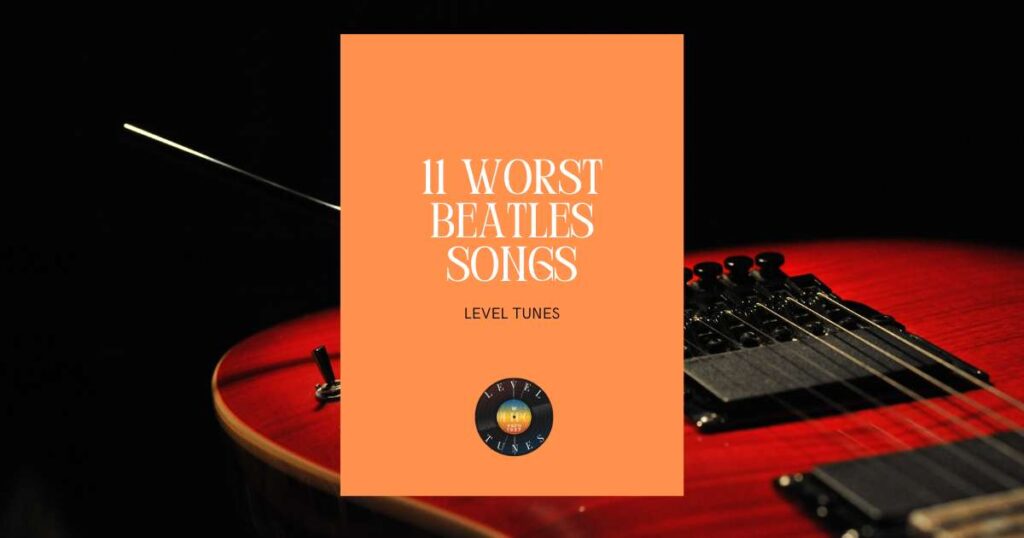11 Worst Beatles Songs: A Unique List
Hey there, fellow music enthusiasts! It’s TBone here from Level Tunes, your go-to DJ and die-hard music fan. Today, I’m diving into a rather intriguing topic that’s sure to spark some lively discussions: the 11 worst Beatles songs.
Now, before you raise your eyebrows, let me explain. We all know The Beatles are legendary, and their influence on music is undeniable. But, even the greatest have their off days, right?
As a DJ and a music lover, I’ve spun countless Beatles tracks and noticed that some just don’t hit the mark.
So, I decided to put together this list not to discredit the Fab Four, but to explore the lesser-known side of their discography.
It’s a journey through the songs that, for various reasons, didn’t shine as bright as their hits. Let’s dive in and explore these tunes with a mix of curiosity and respect for these music icons.
Here are the worst Beatles songs that you can check out:
List Of Worst Beatles Songs
Worst Beatles songs in a list format:
“Revolution 9”
From the album “The White Album” (1968), released under Apple Records, “Revolution 9” is a brainchild of John Lennon with contributions from Yoko Ono. This track is notorious for being one of the most avant-garde and divisive Beatles songs. It’s an experimental piece, filled with tape loops, random sound effects, and disjointed snippets of speech. The reason it makes this list is because of its stark contrast to the Beatles’ typical melodic and lyrical style. It’s more of a sound collage than a song and is often skipped by listeners who prefer the band’s more conventional work.
“Wild Honey Pie”
Also from “The White Album,” “Wild Honey Pie” is a brief, somewhat chaotic track written by Paul McCartney. It’s quite different from the sweet, melodic tunes McCartney is known for. The song features a jarring, repetitive guitar riff and strained vocals. It’s often criticized for its lack of depth and is seen more as a filler track than a significant contribution to the album. The song’s abruptness and lack of traditional structure can be off-putting to many listeners.
“Mr. Moonlight”
Featured on “Beatles for Sale” (1964), under Parlophone Records, “Mr. Moonlight” is originally a cover of a Dr. Feelgood and the Interns song. The Beatles’ version, primarily led by John Lennon with his distinct vocal style, is often critiqued for its overly dramatic delivery and somewhat cheesy organ solo by Paul McCartney. While the band’s ability to cover and reinterpret songs is well-respected, “Mr. Moonlight” falls short for many fans, lacking the innovative spark typical of their original compositions.
“Ob-La-Di, Ob-La-Da”
This track from “The White Album” is a Paul McCartney creation. While it achieved commercial success, it’s often criticized for its perceived superficiality and simplistic lyrics. The song’s attempt at a reggae-like rhythm didn’t resonate well with all listeners, and even John Lennon was reportedly not a fan, considering it too mainstream. The cheerful, upbeat tune contrasts with the deeper, more complex songs on the album, which some argue makes it feel out of place.
“Don’t Pass Me By”
Ringo Starr’s first solo composition for the Beatles, featured on “The White Album,” “Don’t Pass Me By” is a country-inflected tune that diverges from the Beatles’ usual style. While it’s an important track for showcasing Ringo’s songwriting abilities, it’s often seen as less musically and lyrically sophisticated compared to the band’s other works. The song’s somewhat simplistic structure and Ringo’s limited vocal range make it less appealing to some fans.
“Dig It”
Appearing briefly on “Let It Be” (1970), released under Apple Records, “Dig It” is credited to all four Beatles. This impromptu jam session is more of a musical sketch than a fully fleshed-out song. Its inclusion on the album has puzzled many, as it lacks the depth and craftsmanship evident in most of the Beatles’ catalog. The track feels more like an in-studio joke than a serious contribution, making it one of the less appreciated pieces.
“Honey Pie”
From “The White Album,” “Honey Pie” is another McCartney tune that dives into the band’s experimental phase. It’s a pastiche of 1920s jazz, but some fans feel it doesn’t quite capture the charm of that era effectively. While it showcases McCartney’s range as a songwriter, the song is often criticized for being a bit too kitschy and not aligning well with the innovative spirit of the Beatles.
“Maggie Mae”
This traditional Liverpool folk song, briefly covered on “Let It Be,” is a nod to the Beatles’ roots. However, its inclusion on the album is often seen as unnecessary. The track is quite short and feels more like an unfinished rehearsal than a polished song. It lacks the creative depth and production quality typical of the Beatles, making it a less memorable part of their discography.
“What’s the New Mary Jane”
This unreleased track, primarily a John Lennon creation with contributions from Yoko Ono, was recorded during the “White Album” sessions. Known for its avant-garde style, similar to “Revolution 9,” the song was deemed too experimental for release. It’s a chaotic blend of sound effects, disjointed vocals, and abstract lyrics. While interesting from an experimental perspective, it lacks the musical coherence and appeal of the Beatles’ more popular songs.
“Christmas Time (Is Here Again)”
Originally released as part of the Beatles’ annual Christmas records for their fan club, this song, recorded in 1967, is more of a novelty item than a serious musical effort. The repetitive chorus and playful, nonsensical lyrics are in stark contrast to the more thoughtful compositions the band is known for. While it showcases the Beatles’ playful side, it doesn’t stand up to their more critically acclaimed work.
“Little Child”
Featured on “With The Beatles” (1963), under Parlophone Records, “Little Child” is a Lennon-McCartney composition primarily sung by John Lennon with McCartney on harmonica. It’s often overlooked in the Beatles’ catalog due to its relatively simplistic lyrics and melody. The song feels like a filler track, lacking the innovation and depth of the band’s more celebrated songs. While it’s a decent early rock ‘n’ roll number, it pales in comparison to the groundbreaking music the Beatles would later create
Fun Facts: Worst Beatles Songs
“Revolution 9”
- Backward Messages: “Revolution 9” is infamous for its supposed backward messages. When played in reverse, some fans believe they can hear phrases like “Turn me on, dead man,” which fueled the bizarre “Paul is dead” conspiracy theory.
- Yoko Ono’s Influence: This track heavily features the avant-garde influence of Yoko Ono, John Lennon’s wife. It’s one of the earliest examples of the Beatles incorporating experimental and non-musical sound elements into their work.
“Wild Honey Pie”
- Impromptu Creation: Paul McCartney recorded “Wild Honey Pie” spontaneously, with no prior planning. It was more of an experimental piece, done while other band members were occupied with other songs.
- Patti Boyd’s Favorite: Despite its mixed reception, “Wild Honey Pie” was reportedly a favorite of Patti Boyd, George Harrison’s then-wife, which is one reason why it was included on the album.
“Mr. Moonlight”
- Cover Song: “Mr. Moonlight” is actually a cover of a song by Dr. Feelgood and the Interns, showcasing the Beatles’ ability to reinterpret and infuse their style into existing songs.
- Organ Solo: The organ solo by Paul McCartney in “Mr. Moonlight” is often noted for its distinctive sound, differing from the typical Beatles instrumentation.
“Ob-La-Di, Ob-La-Da”
- Creation Frustration: The recording of “Ob-La-Di, Ob-La-Da” was reportedly a frustrating process for the band, taking longer than most songs to complete. John Lennon’s dissatisfaction with the song was well-known, leading to tension during its recording.
- Name Origin: The song’s title came from a phrase used by Nigerian conga player Jimmy Scott, meaning “life goes on.”
“Don’t Pass Me By”
- Ringo’s Debut: This was the first solo composition by Ringo Starr to be included on a Beatles album. It marked an important milestone in his development as a songwriter within the group.
- Long Development: Ringo had been working on “Don’t Pass Me By” for several years before it was finally recorded and included on “The White Album.”
“Honey Pie”
- Paul’s Nostalgia: “Honey Pie” reflects Paul McCartney’s fondness for the music hall style, popular in Britain during his childhood. It was his tribute to this nostalgic genre.
- Hollywood Inspiration: The song was inspired by McCartney’s fascination with the Hollywood sound of the 1920s and 1930s, and it’s meant to evoke the era’s atmosphere.
And there you have it – a tour through some of the Beatles’ lesser-known tracks. Each song, no matter its reception, contributes to the rich tapestry of their legacy. Remember, beauty lies in the ear of the beholder, and every Beatles tune has its unique charm. Keep exploring!
Thanks for reading.
TBone




